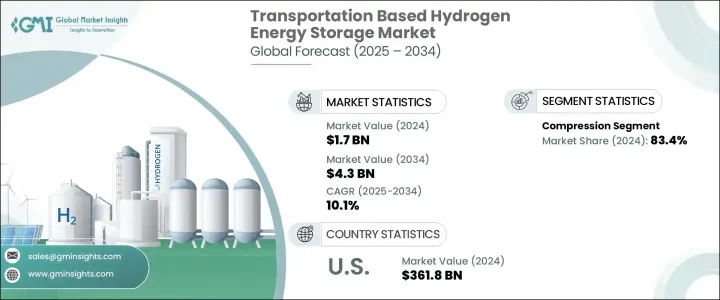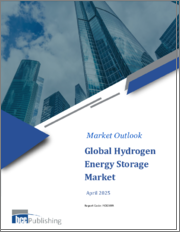
|
시장보고서
상품코드
1716462
수송 기반 수소 에너지 저장 시장 기회, 성장 촉진 요인, 산업 동향 분석, 예측(2025-2034년)Transportation Based Hydrogen Energy Storage Market Opportunity, Growth Drivers, Industry Trend Analysis, and Forecast 2025 - 2034 |
||||||
세계 수송 기반 수소 에너지 저장 시장은 2024년 17억 달러로 평가되었으며, 수소 저장 기술의 발달로 2025년부터 2034년까지 연평균 복합 성장률(CAGR) 10.1%로 성장할 것으로 예상됩니다.
금속 수소화물, 고압 탱크, 액체 수소 저장 솔루션의 채용 증가로 시스템의 효율, 안전성, 성능이 향상되었습니다. 수소 기반 에너지 저장은 트럭, 기차, 비행기 등 장거리 전기 자동차의 지속 가능한 대안으로 주목받고 있습니다. 특히 신흥 경제권에 있어서의 전기자동차의 판매 대수 증가가 수소 저장 솔루션 수요 증가에 기여하고 있어 한층 더 그린 에너지의 도입을 지지하는 정부의 장려책이나 정책에 의해 뒷받침되고 있습니다.

수소 연료 전지는 높은 에너지 밀도, 경량 특성, 긴 수명으로 배터리식 전기자동차에서 선호되는 옵션이 되고 있습니다. 세계 각국의 정부는 이산화탄소 배출량을 줄이기 위해 특히 수송 분야에서 수소에너지 저장을 적극적으로 추진하고 있습니다.
| 시장 범위 | |
|---|---|
| 시작 연도 | 2024년 |
| 예측 연도 | 2025-2034년 |
| 시작 금액 | 17억 달러 |
| 예측 금액 | 43억 달러 |
| CAGR | 10.1% |
수송 기반 수소 에너지 저장 시장은 방법별로 압축, 액화, 재료 기반 저장으로 구분됩니다. 2024년에 전체 시장 점유율의 83.4%를 차지하며 지배적이었습니다. 장기간 에너지를 저장할 수 있기 때문에 수소 저장은 재생 가능 에너지원과 계통 에너지 저장과의 통합도 검토되고 있습니다. 세계 각국은 이러한 노력을 지원하기 위해 유리한 정책과 대규모 에너지 프로젝트를 실시했습니다. 신재생에너지 통합에 널리 이용되는 양수발전은 수소기반 에너지저장 용도의 확대에 중요한 역할을 하고 있습니다.
세계 전기차 판매 대수 증가는 청정에너지 자동차의 채용이 꾸준히 진행되고 있는 가운데 수소 연료전지 수요를 가속화시키고 있습니다. 유럽, 북미, 아시아태평양에서는 각국이 탈탄소화 노력을 우선시하기 때문에 시장은 견고한 확대를 보이고 있습니다. 태양에너지 분야도 현저한 성장을 이루고 있으며, 설치 용량은 2025년 말까지 2TW를 넘을 것으로 예상되고 있습니다. 이 태양광 발전으로의 전환은 수송 분야에서 수소 연료전지의 왕성한 수요를 생성할 것으로 예측됩니다.
도시화, 산업 확대, 노후화된 송전망의 근대화가 수송 기반 수소 에너지 저장에 대한 수요를 더욱 높여주고 있습니다. 각국 정부는 지속 가능한 에너지 솔루션을 추진하기 위해 수소 허브, 재생 가능 에너지 저장 프로젝트, 대규모 인프라 정비에 투자하고 있습니다.
미국에서 수송 기반 수소 에너지 저장 시장은 2022년 3억 510만 달러, 2023년 3억 3,190만 달러, 2024년 3억 6,180만 달러에 이르렀습니다. 에너지 저장 기술에 대한 전략적 투자는 향후 시장 성장을 이끌 것으로 예측됩니다. 중국과 인도 등 신흥국도 비용 효율적인 에너지 저장 시스템의 채용을 가속화하고 있으며, 아시아태평양 수요를 끌어올리고 있습니다.
목차
제1장 조사 방법과 조사 범위
제2장 주요 요약
제3장 업계 인사이트
- 업계 에코시스템
- 규제 상황
- 업계에 미치는 영향요인
- 성장 촉진요인
- 업계의 잠재적 위험 및 과제
- 성장 가능성 분석
- Porter's Five Forces 분석
- PESTEL 분석
제4장 경쟁 구도
- 소개
- 전략 대시보드
- 혁신과 지속가능성의 전망
제5장 시장 규모와 예측 : 제품별, 2021년-2034년
- 주요 동향
- 압축
- 액화
- 재료베이스
제6장 시장 규모와 예측 : 지역별, 2021년-2034년
- 주요 동향
- 북미
- 미국
- 캐나다
- 멕시코
- 유럽
- 독일
- 영국
- 프랑스
- 이탈리아
- 네덜란드
- 러시아
- 아시아태평양
- 중국
- 인도
- 일본
- 세계 기타 지역
제7장 기업 프로파일
- Air Liquide
- Air Products and Chemicals
- Cockerill Jingli Compressed hydrogen
- ENGIE
- FuelCell Energy
- GKN Compressed Hydrogen
- Gravitricity
- ITM Power
- Linde plc
- McPhy Energy
- Nel
- SSE
The Global Transportation Based Hydrogen Energy Storage Market was estimated at USD 1.7 billion in 2024 and is projected to grow at a CAGR of 10.1% from 2025 to 2034, driven by advancements in hydrogen storage technology. The increasing adoption of metal hydrides, high-pressure tanks, and liquid hydrogen storage solutions enhances system efficiency, safety, and performance. Hydrogen-based energy storage is gaining traction as a sustainable alternative for long-range electric vehicles, including trucks, trains, and airplanes. The rise in electric vehicle sales, particularly in emerging economies, contributes to the growing demand for hydrogen storage solutions, further supported by government incentives and policies favoring green energy adoption.

Hydrogen fuel cells are becoming a preferred choice in battery electric vehicles due to their high energy density, lightweight properties, and extended lifespan. Continuous innovations in fuel cell technology are pushing the boundaries of energy efficiency, positioning hydrogen storage as a key component in the future of sustainable transportation. Governments worldwide are actively promoting hydrogen energy storage, particularly in the transportation sector, to reduce carbon emissions. Increasing tourism and rising travel frequency are also fueling the demand for efficient energy storage solutions for long-haul vehicles, including planes and heavy-duty trucks.
| Market Scope | |
|---|---|
| Start Year | 2024 |
| Forecast Year | 2025-2034 |
| Start Value | $1.7 Billion |
| Forecast Value | $4.3 Billion |
| CAGR | 10.1% |
The transportation-based hydrogen energy storage market is segmented by method into compression, liquefaction, and material-based storage. The compression segment dominated in 2024, accounting for 83.4% of the total market share. Due to its ability to store energy for extended periods, hydrogen storage is also being explored for integration with renewable energy sources and grid energy storage. Countries worldwide are implementing favorable policies and large-scale energy projects to support these initiatives. Pumped hydro, widely used in renewable energy integration, is playing a critical role in expanding hydrogen-based energy storage applications.
Rising global electric vehicle sales are accelerating demand for hydrogen fuel cells, with a steady increase in the adoption of clean energy vehicles. The market is witnessing robust expansion in Europe, North America, and Asia-Pacific as nations prioritize decarbonization efforts. The solar energy sector is also experiencing significant growth, with installed capacity expected to surpass 2 TW by the end of 2025. This transition toward solar power is projected to create a strong demand for hydrogen fuel cells in the transportation sector.
Urbanization, industrial expansion, and the modernization of aging power grids are further fueling the demand for transportation-based hydrogen energy storage. Governments are investing in hydrogen hubs, renewable energy storage projects, and large-scale infrastructure improvements to promote sustainable energy solutions.
In the United States, the transportation-based hydrogen energy storage market reached USD 305.1 million in 2022, USD 331.9 million in 2023, and USD 361.8 million in 2024. Strategic investments in energy storage technologies are expected to drive future market growth. Emerging economies such as China and India are also accelerating the adoption of cost-effective energy storage systems, boosting demand across the Asia-Pacific region.
Table of Contents
Chapter 1 Methodology & Scope
- 1.1 Market definitions
- 1.2 Base estimates & calculations
- 1.3 Forecast calculation
- 1.4 Primary research & validation
- 1.4.1 Primary sources
- 1.4.2 Data mining sources
- 1.5 Market Definitions
Chapter 2 Executive Summary
- 2.1 Industry synopsis, 2021 – 2034
Chapter 3 Industry Insights
- 3.1 Industry ecosystem
- 3.2 Regulatory landscape
- 3.3 Industry impact forces
- 3.3.1 Growth drivers
- 3.3.2 Industry pitfalls & challenges
- 3.4 Growth potential analysis
- 3.5 Porter's analysis
- 3.5.1 Bargaining power of suppliers
- 3.5.2 Bargaining power of buyers
- 3.5.3 Threat of new entrants
- 3.5.4 Threat of substitutes
- 3.6 PESTEL analysis
Chapter 4 Competitive landscape, 2024
- 4.1 Introduction
- 4.2 Strategic dashboard
- 4.3 Innovation & sustainability landscape
Chapter 5 Market Size and Forecast, By Product, 2021 – 2034 (USD Million)
- 5.1 Key trends
- 5.2 Compression
- 5.3 Liquefaction
- 5.4 Material-based
Chapter 6 Market Size and Forecast, By Region, 2021 – 2034 (USD Million)
- 6.1 Key trends
- 6.2 North America
- 6.2.1 U.S.
- 6.2.2 Canada
- 6.2.3 Mexico
- 6.3 Europe
- 6.3.1 Germany
- 6.3.2 UK
- 6.3.3 France
- 6.3.4 Italy
- 6.3.5 Netherlands
- 6.3.6 Russia
- 6.4 Asia Pacific
- 6.4.1 China
- 6.4.2 India
- 6.4.3 Japan
- 6.5 Rest of World
Chapter 7 Company Profiles
- 7.1 Air Liquide
- 7.2 Air Products and Chemicals
- 7.3 Cockerill Jingli Compressed hydrogen
- 7.4 ENGIE
- 7.5 FuelCell Energy
- 7.6 GKN Compressed Hydrogen
- 7.7 Gravitricity
- 7.8 ITM Power
- 7.9 Linde plc
- 7.10 McPhy Energy
- 7.11 Nel
- 7.12 SSE



















